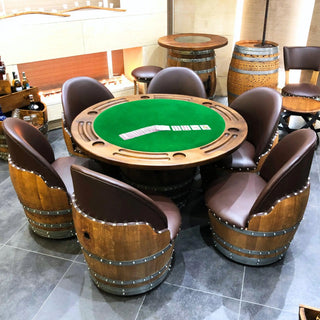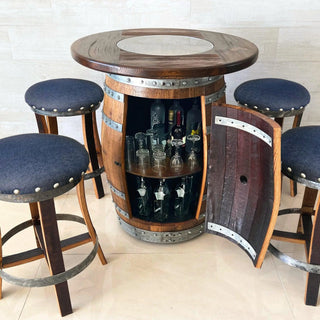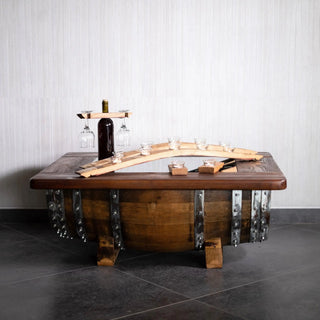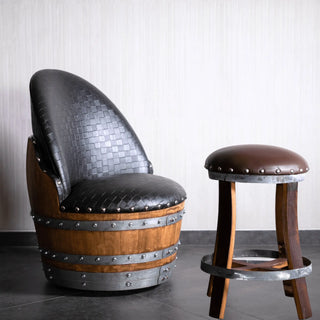Barrel Hoop Repair 101: Stop Loose Metal Rings from Slipping or Falling
If you’ve owned a wine or whiskey barrel for a while, you’ve probably had this heart-sinking moment: you walk outside with your morning coffee, glance over at your favorite oak barrel table or planter, and notice one of the metal bands—those beautiful old hoops—has slipped down a few inches.
Suddenly, your barrel looks tired and droopy, like it’s melting into itself.
Before you panic or think it’s done for, take a breath. This is one of the most common barrel issues—and one of the easiest to fix. In fact, tightening up a hoop and bringing your barrel back to life can be oddly satisfying. You’ll feel like a cooper (that’s the old-school word for barrel maker) for a day.
So grab a mallet, a towel, and a little patience—let’s get that barrel looking strong, proud, and beautiful again.
Why Barrel Hoops Matter (and Why They Slip in the First Place)
Those iron or steel hoops are more than decoration—they’re literally the bones holding your barrel together. They keep the curved oak staves tight and perfectly compressed, giving the barrel its shape and structure.
When the hoops loosen or slide down, it’s not because the metal gave up—it’s because the oak got thirsty.
Real oak breathes. When it’s exposed to heat or dry air, the wood contracts slightly, just enough to loosen the hoops. When it’s humid, the oak expands again. It’s nature’s tug-of-war.
That’s why your barrel might look tight and solid all spring, then suddenly sag by mid-summer.
Step 1: Give the Barrel Some Moisture Therapy
Before you start hammering anything back into place, you need to help the oak rehydrate. Think of it like giving your barrel a long drink of water after a hot day.
Here’s the trick:
- Lightly mist the barrel with clean water. Don’t drench it—just enough to moisten the surface evenly.
- Wrap it up in a damp towel, old T-shirt, or burlap sack. This helps trap humidity.
- Let it sit overnight in a cool, shaded spot.
By morning, the oak will have plumped back up just enough to tighten slightly around the hoops again. You might already see the rings start to feel firmer.
Sometimes, that alone fixes the issue. If not—don’t worry. Now it’s time to play cooper.
Step 2: Tap the Hoops Back Up Like a Pro
This is the fun part—it’s where you feel like you’re giving your barrel a heartbeat again.
What you’ll need:
- A rubber mallet (or a small wooden one)
- A soft towel or cloth to protect the metal
- A steady hand (and maybe your favorite playlist)
Here’s how you do it:
Wrap the towel over the edge of the hoop to avoid scratching it. Hold the mallet at an angle and gently tap the hoop upward, working around the barrel a few inches at a time.
Don’t whack it like you’re breaking rocks—just small, rhythmic taps. You’ll feel the hoop slide into its groove and settle.
Keep going until it’s even and snug. Once all the hoops look aligned again, give the whole barrel a little shake—it should feel tight and solid. No wobbles, no squeaks.
That’s the moment you’ll grin. Because it feels like you just brought something old back to life.
Step 3: Keep It Tight — Seal and Protect
Now that everything’s snug again, let’s keep it that way. The best way to prevent hoops from slipping again is to keep the oak hydrated and protected.
- Wipe down the entire barrel with tung oil, linseed oil, or Danish oil. It nourishes the wood from within and prevents drying.
- If your barrel lives outdoors, follow with a thin coat of marine varnish or outdoor polyurethane. It’ll block moisture, UV rays, and temperature swings.
- If you live in a super dry area, give your barrel a light mist of water once every few weeks—just enough to remind the oak that it’s loved.
Optional “Never-Slip” Trick:
For decorative barrels that won’t be used for liquids, you can gently drive a tiny screw through the hoop into a stave. Go shallow—just enough to hold it. You won’t see it, but it’ll keep the hoop right where it belongs.
Step 4: Clean and Polish the Metal (Don’t Skip This Part)
If your barrel’s been sitting out for a while, those metal bands might look dull or rusty. You’d be amazed what a quick polish can do.
- Use fine steel wool or a wire brush to remove rust or oxidation.
- Wipe clean with a damp cloth and dry thoroughly.
- Apply a thin coat of clear metal lacquer or matte black paint (depending on your vibe).
A clean, sealed hoop isn’t just prettier—it’s less likely to expand, corrode, or slip in the future.
Step 5: When Things Get a Little More Complicated
If one of your hoops is actually bent or misshapen, don’t panic. It’s fixable.
- Carefully remove the hoop (you might need to loosen a few staves gently).
- Lay it flat on a sturdy surface.
- Tap it with your mallet until it regains a round shape.
- Slide it back over the barrel and reseat it using the same tapping method from Step 2.
If the hoop feels too wide to stay on, you can tighten it slightly by overlapping the ends a millimeter and hammering them together—old coopers used to do this by eye and hand.
It’s old-fashioned, but it works beautifully.
Bonus: Keep Your Barrel in Top Shape
Once your hoops are snug and your barrel looks refreshed, a little regular care will keep it strong for years:
- Avoid direct sunlight—it dries oak faster than you’d think.
- Re-oil the wood every 6–12 months.
- Keep it slightly elevated if it’s outdoors (a few wood blocks or rubber feet work great).
- Don’t let rainwater pool underneath—it’s the silent killer of every outdoor barrel.
A little love goes a long way. These barrels have already survived decades of winemaking—you’re just helping them age gracefully in retirement.
Our Links
- Learn from our full barrel restoration and maintenance guides.
- Explore our collection of handcrafted oak barrel furniture and décor built from real reclaimed wine casks.
- Get expert advice from Oak Wood Wine Barrels’ workshop on keeping your furniture strong, tight, and beautiful.
Other Resources to Check Out!
- Bob Vila: How to Restore and Maintain Outdoor Wood Structures
- The Wood Whisperer: Fixing Loose Hardware on Furniture
- HomeTalk: Creative Ways to Refinish Wine Barrels at Home
You’ll know you’ve done the job right when you step back, run your hand over that cool metal, and hear that faint “thunk” of tight wood when you tap it. It’s one of those small, deeply satisfying wins that make working with reclaimed wood so rewarding.
Because here’s the truth—barrels aren’t just furniture. They’re survivors. They’ve lived full lives in wineries and distilleries, carried stories in their grain, and now they’ve found new purpose in your home.
When you take the time to repair, restore, and protect them, you’re not just fixing something old—you’re honoring craftsmanship, history, and the kind of timeless beauty that doesn’t fade.
So next time your barrel’s hoop starts to slip, smile a little. You’ve got this. And your barrel? It’s got decades left in it.
Disclaimer
This article is provided for educational and informational purposes only. The repair techniques described here are based on personal woodworking and restoration experience. Always use safety gear, proper tools, and caution when working with wood and metal.
Oak Wood Wine Barrels is not responsible for injury, property damage, or product variations resulting from DIY repair attempts. Methods and finishes may evolve as craftsmanship improves.
For professional restoration or to explore our handcrafted line of reclaimed oak barrel furniture, visit OBARREL.COM — where every barrel tells its story, and every hoop holds it together.




